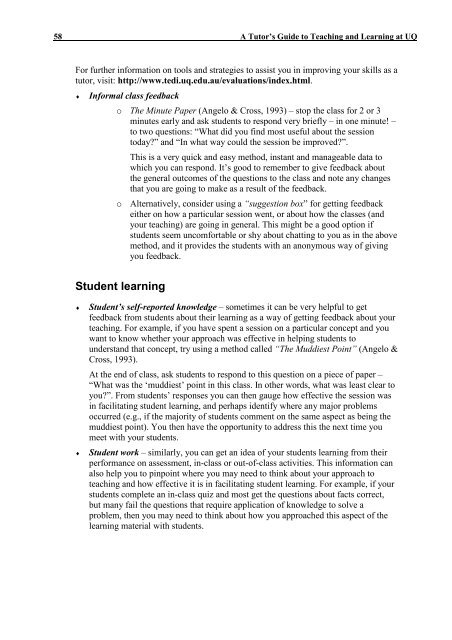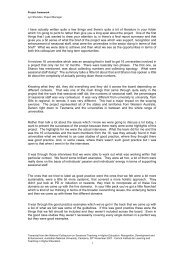A tutor's guide to teaching and learning at UQ - TEDI - University of ...
A tutor's guide to teaching and learning at UQ - TEDI - University of ...
A tutor's guide to teaching and learning at UQ - TEDI - University of ...
You also want an ePaper? Increase the reach of your titles
YUMPU automatically turns print PDFs into web optimized ePapers that Google loves.
58 A Tu<strong>to</strong>r’s Guide <strong>to</strong> Teaching <strong>and</strong> Learning <strong>at</strong> <strong>UQ</strong>For further inform<strong>at</strong>ion on <strong>to</strong>ols <strong>and</strong> str<strong>at</strong>egies <strong>to</strong> assist you in improving your skills as <strong>at</strong>u<strong>to</strong>r, visit: http://www.tedi.uq.edu.au/evalu<strong>at</strong>ions/index.html.♦Informal class feedbacko The Minute Paper (Angelo & Cross, 1993) – s<strong>to</strong>p the class for 2 or 3minutes early <strong>and</strong> ask students <strong>to</strong> respond very briefly – in one minute! –<strong>to</strong> two questions: “Wh<strong>at</strong> did you find most useful about the session<strong>to</strong>day?” <strong>and</strong> “In wh<strong>at</strong> way could the session be improved?”.This is a very quick <strong>and</strong> easy method, instant <strong>and</strong> manageable d<strong>at</strong>a <strong>to</strong>which you can respond. It’s good <strong>to</strong> remember <strong>to</strong> give feedback aboutthe general outcomes <strong>of</strong> the questions <strong>to</strong> the class <strong>and</strong> note any changesth<strong>at</strong> you are going <strong>to</strong> make as a result <strong>of</strong> the feedback.o Altern<strong>at</strong>ively, consider using a “suggestion box” for getting feedbackeither on how a particular session went, or about how the classes (<strong>and</strong>your <strong>teaching</strong>) are going in general. This might be a good option ifstudents seem uncomfortable or shy about ch<strong>at</strong>ting <strong>to</strong> you as in the abovemethod, <strong>and</strong> it provides the students with an anonymous way <strong>of</strong> givingyou feedback.Student <strong>learning</strong>♦♦Student’s self-reported knowledge – sometimes it can be very helpful <strong>to</strong> getfeedback from students about their <strong>learning</strong> as a way <strong>of</strong> getting feedback about your<strong>teaching</strong>. For example, if you have spent a session on a particular concept <strong>and</strong> youwant <strong>to</strong> know whether your approach was effective in helping students <strong>to</strong>underst<strong>and</strong> th<strong>at</strong> concept, try using a method called “The Muddiest Point” (Angelo &Cross, 1993).At the end <strong>of</strong> class, ask students <strong>to</strong> respond <strong>to</strong> this question on a piece <strong>of</strong> paper –“Wh<strong>at</strong> was the ‘muddiest’ point in this class. In other words, wh<strong>at</strong> was least clear <strong>to</strong>you?”. From students’ responses you can then gauge how effective the session wasin facilit<strong>at</strong>ing student <strong>learning</strong>, <strong>and</strong> perhaps identify where any major problemsoccurred (e.g., if the majority <strong>of</strong> students comment on the same aspect as being themuddiest point). You then have the opportunity <strong>to</strong> address this the next time youmeet with your students.Student work – similarly, you can get an idea <strong>of</strong> your students <strong>learning</strong> from theirperformance on assessment, in-class or out-<strong>of</strong>-class activities. This inform<strong>at</strong>ion canalso help you <strong>to</strong> pinpoint where you may need <strong>to</strong> think about your approach <strong>to</strong><strong>teaching</strong> <strong>and</strong> how effective it is in facilit<strong>at</strong>ing student <strong>learning</strong>. For example, if yourstudents complete an in-class quiz <strong>and</strong> most get the questions about facts correct,but many fail the questions th<strong>at</strong> require applic<strong>at</strong>ion <strong>of</strong> knowledge <strong>to</strong> solve aproblem, then you may need <strong>to</strong> think about how you approached this aspect <strong>of</strong> the<strong>learning</strong> m<strong>at</strong>erial with students.



